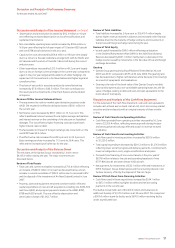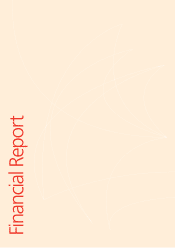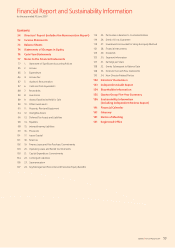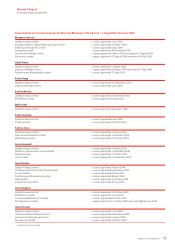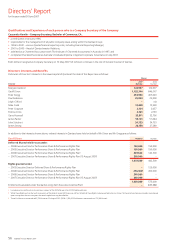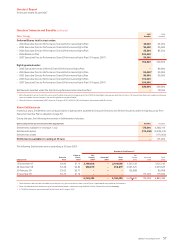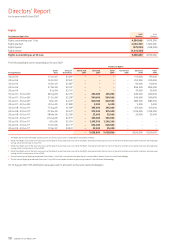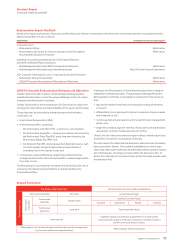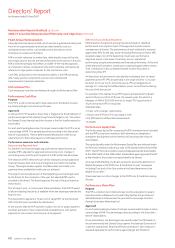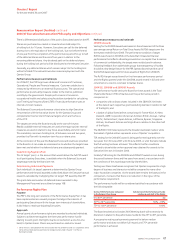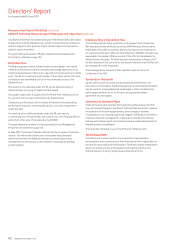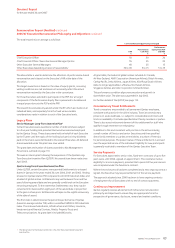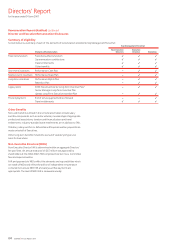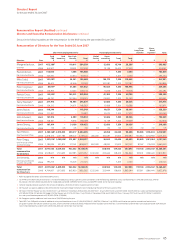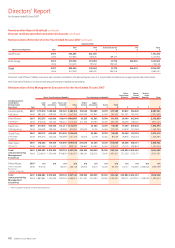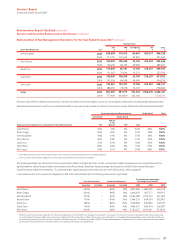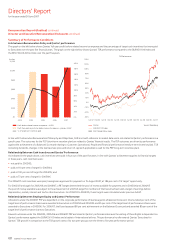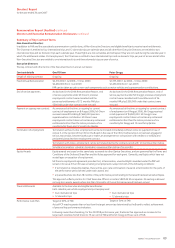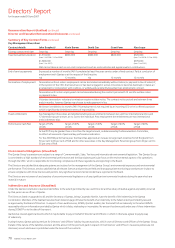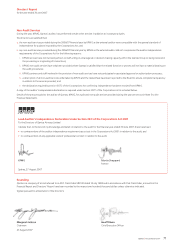Qantas 2007 Annual Report Download - page 63
Download and view the complete annual report
Please find page 63 of the 2007 Qantas annual report below. You can navigate through the pages in the report by either clicking on the pages listed below, or by using the keyword search tool below to find specific information within the annual report.
61Qantas |Annual Report 2007
Directors’ Report
for the year ended 30 June 2007
There is differentiated distribution of the pool to Executives based on the IPF.
Shares are purchased on-market or issued and are held subject to
a holding lock for 10 years. However, Executives can call for the deferred
shares prior to the expiration of the holding lock, but not before the end
of one year from the completion of the performance period for up to half
of the deferred shares and the end of two years in relation to the
remaining deferred shares. Any dividends paid on the deferred shares
during the holding lock period will be distributed to the relevant Executive.
Generally, any deferred shares which remain subject to the holding lock
will be forfeited if the relevant Executive ceases employment with the
Qantas Group.
Performance measures and rationale
For 2006/07, the PSP target was a Balanced Scorecard of Customer,
Operational, People and Financial measures. Customer satisfaction is
measured by reference to an external Skytrax survey. The operational
performance (punctuality) measure relates to the metrics published
monthly by the government. People performance is focused on
occupational health and safety using Australian standards for calculating
Lost Time Injury Frequency Rate (LTIFR). Financial performance uses an
internal unit cost measure.
The Balanced Scorecard performance criteria aims to align Executive
remuneration with the key value drivers for the Qantas Group and
complements the short-term financial targets which are the focus
of the PCP.
The targets are set by the Board annually at the start of the year.
Readily available external measures are used where appropriate. Internal
measures are used in relation to key focus areas (Safety and Unit Costs).
The mandatory minimum holding lock, of between one and two years,
provides this Plan with its medium-term focus on share price.
At the conclusion of the year the Balanced Scorecard results are provided
to the Board so it can make an assessment as to whether the targets have
been met and whether the deferred shares are subsequently granted.
Determining Payment Pool
The ‘at target’ pool, i.e. the amount that would deliver the full PSP award
to all participating Executives, is available when the Balanced Scorecard
targets approved by the Board are met.
Determining Individual Payments
Each individual’s ‘at target’ payment is determined by Qantas Group
performance and the pool awarded as described above. An Executive’s actual
reward is calculated by multiplying their ‘at target’ PSP award by their IPF.
The grant date and number of deferred shares awarded to Key
Management Personnel are outlined on page 108.
Performance Rights Plan
Purpose
The PRP is the long-term element of the Performance Equity Plan. It has
been implemented as a reward program that aligns the interests of
participating Executives with the longer term interests of shareholders.
It also helps to retain participating Executives.
Approach
Annual grants of performance rights are awarded to selected individuals.
Subject to achievement against the three year performance hurdle
relating to each grant, the Rights may be converted (on a one-for-one
basis) to Qantas shares. Shares are purchased on-market or issued.
Performance measures and rationale
2003/04 Awards
Vesting for the 2003/04 award was based on the achievement of the three
year average annual Return on Total Gross Assets (RoTGA) targets over the
three years ended 30 June 2006. The performance condition of target
RoTGA was chosen in 2003/04 on the basis that it measures financial
performance that reflects a Board approved return on capital. Due to reasons
of commercial confidentiality, the targets were not disclosed in advance.
Following feedback from stakeholder groups that transparency of hurdles
should be a key design feature for the PRP, Qantas discontinued the use of
this RoTGA based approach for future awards of Rights from 2004/05.
The RoTGA target was achieved for the three year performance period
and the Rights granted under the 2003/04 award vested in full and were
converted on a one-for-one basis to Qantas shares.
2004/05, 2005/06 and 2006/07 Awards
The performance hurdle set by the Board for these awards is the Total
Shareholder Return (TSR) of Qantas over the performance period in
comparison to:
companies with ordinary shares included in the S&P/ASX 100 Index
at the date of each respective grant (excluding Qantas) in relation to half
of the Rights; and
a basket of global listed airlines comprising Air France-KLM, Air New
Zealand, AMR Corporation (American Airlines), British Airways, Cathay
Pacific, Delta Airlines1, Japan Airlines, Lufthansa, Ryanair, Singapore
Airlines, Southwest Airlines and Virgin Blue in relation to the other half
of the Rights.
The S&P/ASX 100 Index represents the broader Australian market, while
the basket of global airlines represents a mix of Qantas’ competitors.
TSR testing for the 2004/05 award is being performed quarterly over the
two years from 30 June 2007 until 30 June 2009, or until the tests indicate
that full vesting has been achieved. This reflects the Plan conditions
outlined to shareholders when approval was obtained for awards to the
Executive Directors in October 2004.
Similarly TSR testing for the 2005/06 and 2006/07 awards occurs during
the period between three and five years from award, in accordance with
the conditions of the awards approved by shareholders.
Testing over these timeframes recognises that Qantas is exposed to a high
degree of business and share price volatility compared to many other
major Australian companies. As the award date remains the base point for
comparison, it ensures that there is no reduction in the rigour of the
performance requirement.
The performance hurdle will be considered satisfied in accordance with
the following table:
Qantas TSR Performance Compared
to the Relevant Peer Group
Satisfaction of the Performance Hurdle
relatingtoeachhalfoftheRights
0 to 49th percentile Nil
50th to 74th percentile 50% – 99%
75th to 100th percentile 100%
The Board resolved at its October 2005 Meeting that it will not exercise its
discretion in relation to the performance hurdle for the 25th to 49th percentile.
A progressive vesting scale prevents payment for below median
performance and does not deliver full reward until 75th percentile
performance is achieved.
•
•
Delta Airlines is excluded from the airline basket for the 2006/07 award as in September 2005
Delta Airlines filed voluntary petitions for reorganisation under Chapter 11 of the US
Bankruptcy Code.
1
Remuneration Report (Audited) continued
2006/07 Executive Remuneration Philosophy and Objectives continued


